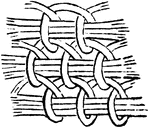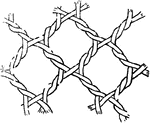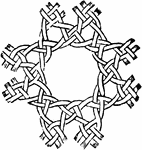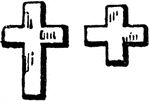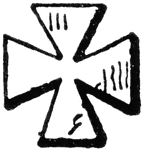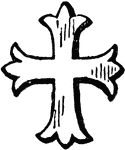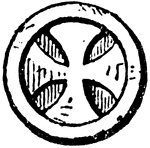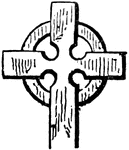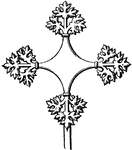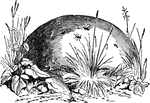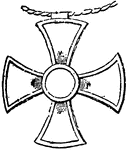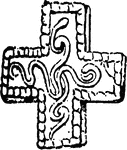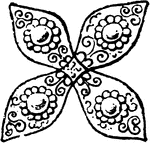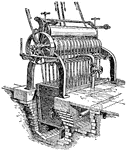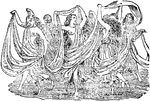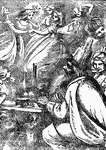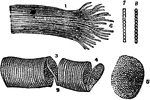
Striped Muscle
"1, longitudinal section; 2, 3, 4, cross section; 5, detached disk; 7, 8, fibrillae." — Richardson,…
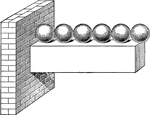
Cantilever
"When the load is uniformly distributed on a cantilever of any cross-section, it will sustain a load…

Beam Strength
"When the load is uniformly distributed on a beam of any cross-section, it will sustain a load twice…

English Coin
"The pennies of the Saxon and Danish sole monarches of England had a portrait on them. Alfred's earlier…
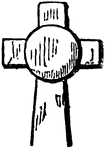
Worcestershire
"The gable cross of Washburn Chirch in Worcestershire." — Encyclopedia Britannica, 1893

Dannebrog
"The cross of the Danisn order of the Dannebrog, a white cross surmounting a red one, with the royal…
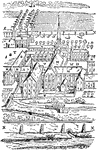
Bird Eye View of Citeaux
A. Cross, B. Gate-house, C. Almonry, D. Chapel, E. Inner gate-house, F. Stable, G. Dormitory of lay…

Pyramid Pruning
"a shows a young tree with its second year's growth, the upright shoot of the maiden tree having been…
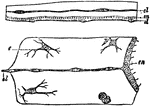
Medusae
"Portions of sections through the disc of medusae. The upper one of Lizzia, the lower of Aurelia. el,…

Arquebus
"The first form of hand-gun which could fairly be compared with the modern musket. those of earlier…

Balistraria
"One of the names given to those narrow apertures so often seen in the walls of old castles, and through…
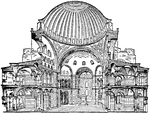
Hagia Sophia
Cross section of Hagia Sophia in Istanbul (historically Constantinople). The Greek name Hagia Sophia…

London City
"London City and Midland Bank, Ludgate Hill Branch." — The Encyclopedia Britannica, 1910

Brasses
"Sepulchral or monumental, large plates of brass inlaid in polished slabs of stone, and usually exhibiting…
Gravel Hill
"Suppose a to be a gravel hill, and b a strata of clay or rock, impervious to water. The fluid percolating…

Currying Knife
"The knife is a double-edged rectangular blade, about 12 inches by 5 inches, with a straight handle…

Camera Obscura
"Camera obscura strictly signifies a darkened chamber, because the room must be darkened, in order to…
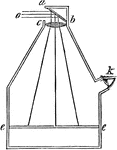
Camera Obscura
"Camera obscura strictly signifies a darkened chamber, because the room must be darkened, in order to…
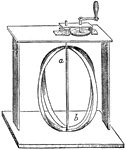
Pole Depression
"Two hoops of thin iron are placed upon an axis which passes through their poles. The two ends of each…
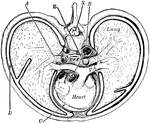
Thorax
"Cross-section of thorax. A, bronchus, entering the lung; B, the aorta cut at its origin and again at…
Medulla Oblongata
"The spinal cord and medulla oblongata. A, from the ventral, and B, from the dorsal aspect; C to H,…

Nerve Roots
"The spinal cord and nerve-roots. A, a small portion of the cord seen from the ventral side; B, the…

Bone Section
Cross-section of bone, a microscopic view. 1: Cells; 2: Canals; 3: Intercellular substance.
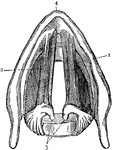
Larynx
Cross section of the larynx above the vocal cords. 1: Right vocal cord. 2: Left vocal cord. 3: Cartilages…
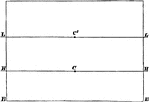
Horizontal Line Diagram
In this figure BB is the base line; HH the common horizontal or vanishing line; C…

Deadly Nightshade
A flowering branch. 1, flower after removal of the corolla; 2, corolla, with stamens cut open and flattened;…
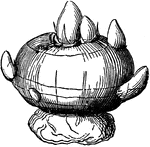
Corm of a Crocus
The investing sheaths or dead leaf-bases striped off. The faint cross-lines represent the scars, where…
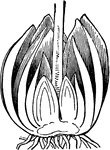
Wild Lily Cross-Section
Wild Lily divided lengthwise, showing two forming buds of the next generation.
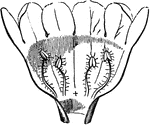
Gerardia
Corolla of a purple Gerardia laid open, showing the four stamens; the cross shows where the fifth stamen…

Christ Falling Under the Cross
A painting by Johann Overbeck. It is from a Drawing in the Dreden Print Room.

Ovary of Frost Weed
Cross section of the ovary of Frost-Weed (Helianthemum), with three parietal placenta, bearing ovules.
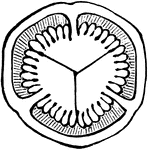
Hypericum graveolens
Cross-section of an ovary of Hypericum graveolens, the three large placenta meeting in the centre, so…
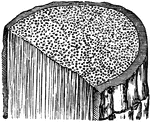
Palm-stem
A Palm-stem in transverse and longitudinal section, the dots on the cross sections represent cut ends…
